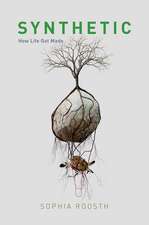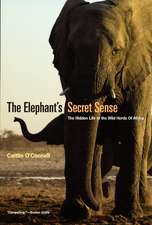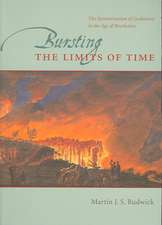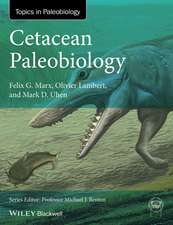Worlds Before Adam: The Reconstruction of Geohistory in the Age of Reform: Emersion: Emergent Village resources for communities of faith
Autor Martin J. S. Rudwicken Limba Engleză Paperback – 24 mai 2010
In the late eighteenth and early nineteenth centuries, scientists reconstructed the immensely long history of the earth—and the relatively recent arrival of human life. The geologists of the period, many of whom were devout believers, agreed about this vast timescale. But despite this apparent harmony between geology and Genesis, these scientists still debated a great many questions: Had the earth cooled from its origin as a fiery ball in space, or had it always been the same kind of place as it is now? Was prehuman life marked by mass extinctions, or had fauna and flora changed slowly over time?
The first detailed account of the reconstruction of prehuman geohistory, Martin J. S. Rudwick’s Worlds Before Adam picks up where his celebrated Bursting the Limits of Time leaves off. Here, Rudwick takes readers from the post-Napoleonic Restoration in Europe to the early years of Britain’s Victorian age, chronicling the staggering discoveries geologists made during the period: the unearthing of the first dinosaur fossils, the glacial theory of the last ice age, and the meaning of igneous rocks, among others. Ultimately, Rudwick reveals geology to be the first of the sciences to investigate the historical dimension of nature, a model that Charles Darwin used in developing his evolutionary theory.
Featuring an international cast of colorful characters, with Georges Cuvier and Charles Lyell playing major roles and Darwin appearing as a young geologist, Worlds Before Adam is a worthy successor to Rudwick’s magisterial first volume. Completing the highly readable narrative of one of the most momentous changes in human understanding of our place in the natural world, Worlds Before Adam is a capstone to the career of one of the world’s leading historians of science.
The first detailed account of the reconstruction of prehuman geohistory, Martin J. S. Rudwick’s Worlds Before Adam picks up where his celebrated Bursting the Limits of Time leaves off. Here, Rudwick takes readers from the post-Napoleonic Restoration in Europe to the early years of Britain’s Victorian age, chronicling the staggering discoveries geologists made during the period: the unearthing of the first dinosaur fossils, the glacial theory of the last ice age, and the meaning of igneous rocks, among others. Ultimately, Rudwick reveals geology to be the first of the sciences to investigate the historical dimension of nature, a model that Charles Darwin used in developing his evolutionary theory.
Featuring an international cast of colorful characters, with Georges Cuvier and Charles Lyell playing major roles and Darwin appearing as a young geologist, Worlds Before Adam is a worthy successor to Rudwick’s magisterial first volume. Completing the highly readable narrative of one of the most momentous changes in human understanding of our place in the natural world, Worlds Before Adam is a capstone to the career of one of the world’s leading historians of science.
| Toate formatele și edițiile | Preț | Express |
|---|---|---|
| Paperback (1) | 439.57 lei 43-57 zile | |
| University of Chicago Press – 24 mai 2010 | 439.57 lei 43-57 zile | |
| Hardback (1) | 527.55 lei 43-57 zile | |
| University of Chicago Press – 17 iul 2008 | 527.55 lei 43-57 zile |
Din seria Emersion: Emergent Village resources for communities of faith
-
 Preț: 144.99 lei
Preț: 144.99 lei -
 Preț: 133.99 lei
Preț: 133.99 lei - 9%
 Preț: 352.50 lei
Preț: 352.50 lei -
 Preț: 146.50 lei
Preț: 146.50 lei -
 Preț: 208.31 lei
Preț: 208.31 lei -
 Preț: 156.84 lei
Preț: 156.84 lei -
 Preț: 115.53 lei
Preț: 115.53 lei -
 Preț: 548.71 lei
Preț: 548.71 lei - 8%
 Preț: 346.31 lei
Preț: 346.31 lei - 8%
 Preț: 360.28 lei
Preț: 360.28 lei -
 Preț: 216.89 lei
Preț: 216.89 lei -
 Preț: 101.43 lei
Preț: 101.43 lei -
 Preț: 215.51 lei
Preț: 215.51 lei -
 Preț: 185.37 lei
Preț: 185.37 lei - 8%
 Preț: 563.24 lei
Preț: 563.24 lei -
 Preț: 179.04 lei
Preț: 179.04 lei -
 Preț: 106.35 lei
Preț: 106.35 lei -
 Preț: 138.81 lei
Preț: 138.81 lei -
 Preț: 273.93 lei
Preț: 273.93 lei -
 Preț: 128.11 lei
Preț: 128.11 lei - 9%
 Preț: 353.24 lei
Preț: 353.24 lei -
 Preț: 176.49 lei
Preț: 176.49 lei -
 Preț: 94.22 lei
Preț: 94.22 lei -
 Preț: 144.80 lei
Preț: 144.80 lei -
 Preț: 126.25 lei
Preț: 126.25 lei -
 Preț: 67.35 lei
Preț: 67.35 lei -
 Preț: 163.52 lei
Preț: 163.52 lei -
 Preț: 138.26 lei
Preț: 138.26 lei -
 Preț: 182.98 lei
Preț: 182.98 lei - 18%
 Preț: 502.35 lei
Preț: 502.35 lei - 18%
 Preț: 2261.34 lei
Preț: 2261.34 lei -
 Preț: 279.55 lei
Preț: 279.55 lei -
 Preț: 115.82 lei
Preț: 115.82 lei -
 Preț: 208.54 lei
Preț: 208.54 lei -
 Preț: 167.85 lei
Preț: 167.85 lei -
 Preț: 160.63 lei
Preț: 160.63 lei -
 Preț: 183.89 lei
Preț: 183.89 lei - 9%
 Preț: 352.77 lei
Preț: 352.77 lei -
 Preț: 307.53 lei
Preț: 307.53 lei - 12%
 Preț: 290.56 lei
Preț: 290.56 lei - 8%
 Preț: 311.68 lei
Preț: 311.68 lei -
 Preț: 120.81 lei
Preț: 120.81 lei -
 Preț: 229.92 lei
Preț: 229.92 lei - 6%
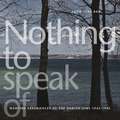 Preț: 324.95 lei
Preț: 324.95 lei -
 Preț: 145.41 lei
Preț: 145.41 lei -
 Preț: 125.41 lei
Preț: 125.41 lei -
 Preț: 147.26 lei
Preț: 147.26 lei - 18%
 Preț: 348.59 lei
Preț: 348.59 lei -
 Preț: 302.76 lei
Preț: 302.76 lei - 8%
 Preț: 564.99 lei
Preț: 564.99 lei
Preț: 439.57 lei
Nou
Puncte Express: 659
Preț estimativ în valută:
84.11€ • 88.05$ • 69.60£
84.11€ • 88.05$ • 69.60£
Carte tipărită la comandă
Livrare economică 07-21 aprilie
Preluare comenzi: 021 569.72.76
Specificații
ISBN-13: 9780226731292
ISBN-10: 0226731294
Pagini: 648
Ilustrații: 125 halftones, 40 line drawings
Dimensiuni: 178 x 254 x 38 mm
Greutate: 1.72 kg
Editura: University of Chicago Press
Colecția University of Chicago Press
Seria Emersion: Emergent Village resources for communities of faith
ISBN-10: 0226731294
Pagini: 648
Ilustrații: 125 halftones, 40 line drawings
Dimensiuni: 178 x 254 x 38 mm
Greutate: 1.72 kg
Editura: University of Chicago Press
Colecția University of Chicago Press
Seria Emersion: Emergent Village resources for communities of faith
Notă biografică
Martin J. S. Rudwick is research associate in the department of History and Philosophy of Science at the University of Cambridge and professor emeritus of history at the University of California, San Diego. He is the author of Bursting the Limits of Time,The Meaning of Fossils, The Great Devonian Controversy, Scenes from Deep Time, and Georges Cuvier, all published by the University of Chicago Press. He was awarded the Sarton Medal of the History of Science Society in 2007.
Cuprins
List of illustrations
Acknowledgments
A note on footnotes, references, and quotations
Introduction
PART ONE
1. Cuvier's model for geohistory (1817–25)
§1.1 Cuvier's Fossil Bones--§1.2 The Fossil Bones revised--§1.3 Cuvier's secular resurrection--§1.4 Conclusion
2. Monsters from deep time (1819–24)
§2.1 The strange ichthyosaur--§2.2 The Geological Society--§2.3 Conybeare's plesiosaur--§2.4 Conclusion
3. The new stratigraphy (1817–25)
§3.1 The practice of geognosy--§3.2 "Conybeare and Phillips"--§3.3 The stratigraphy of Europe--§3.4 Conclusion
4. Outlines of life's history (1818–27)
§4.1 "Paleontology" defined--§4.2 Life's own history--§4.3 The life of ancient seas--§4.4 Ancient plant life--§4.5 Conclusion
5. Ancient monsters on land (1818–25)
§5.1 Buckland's megalosaur--§5.2 Mantell's giant herbivore--§5.3 Wealden stratigraphy--§5.4 Mantell's iguanodon--§5.5 The Stonesfield marsupials--§5.6 Conclusion
6. Geological deluge and biblical Flood (1819–24)
§6.1 Buckland's "hyaena story" at Kirkdale--§6.2 Buckland's new "diluvial" evidence--§6.3 "Relics of the deluge"--§6.4 Critics of the deluge--§6.5 Conclusion
7. The role of actual causes (1818–24)
§7.1 The adequacy of actual causes--§7.2 Von Hoff and Nature's "statistics"--§7.3 Etna: Europe's greatest volcano--§7.4 Actual causes and global exploration--§7.5 Conclusion
8. The dynamic earth (1818–24)
§8.1 Crustal elevation--§8.2 The "Temple of Serapis"-- §8.3 Von Buch and the origin of mountain ranges--§8.4 Conclusion
PART TWO
9. The engine of geohistory (1824–29)
§9.1 Brongniart's global stratigraphy--§9.2 Fourier's physics of a cooling earth--§9.3 Scrope's directional geotheory--§9.4 Élie de Beaumont's sequence of revolutions--§9.5 Conclusion
10. The Tertiary gateway (1824–27)
§10.1 The adequacy of actual causes--§10.2 Interpreting the Tertiary world--§10.3 Prévost's reinterpretation of the Paris Basin--§10.4 Conclusion
11. The geologists' time-machine (1825–31)
§11.1 Fossil land surfaces and soils--§11.2 Buckland and the footprints of monsters--§11.3 First scenes from deep time--§11.4 Conclusion
12. A directional history of life (1825–31)
§12.1 Tertiary geohistory--§12.2 Adolphe Brongniart: plant life on a cooling earth--§12.3 Tropics in the Arctic?--§12.4 Conclusion
13. The last revolution (1824–30)
§13.1 Alluvium and diluvium--§13.2 Alpine erratic blocks--§13.3 Erratic blocks in Scandinavia--§13.4 Esmark's glacial conjecture--§13.5 Conclusion
14. The last mass extinction (1826–31)
§14.1 Bone caves for Buckland--§14.2 Buckland's worldwide antediluvial fossils--§14.3 Fleming and the course of extinction--§14.4 Lyell the budding synthesizer--§14.5 Conclusion
15. The centrality of central France (1826–28)
§15.1 Scrope's "Time!--Time!--Time!"--§15.2 Faunas and volcanoes in Auvergne--§15.3 Conclusion
16. Men among the mammoths? (1825–30)
§16.1 The question of contemporaneity--§16.2 Human fossils in Languedoc--§16.3 Province and metropolis--§16.4 Conclusion
17. The specter of transmutation (1825–29)
§17.1 Geoffroy's new transformism--§17.2 Lyell confronts Lamarck--§17.3 Conclusion
PART THREE
18. Lyell and Auvergne geology (1827–28)
§18.1 Lyell on Scrope's Auvergne--§18.2 Lyell as geological reformer--§18.3 Auvergne through Lyell's eyes--§18.4 Conclusion
19. A geological Grand Tour (1828)
§19.1 Lyell and Murchison in southern France--§19.2 Lyell and Murchison in northern Italy--§19.3 Lyell in southern Italy--§19.4 Lyell in Sicily--§19.5 Conclusion
20. Lyell in European context (1829–30)
§20.1 Lyell's homeward journey--§20.2 Parisian debates on the Tertiaries--§20.3 Diluvialists and fluvialists in London--§20.4 Sedgwick's anniversary address--§20.5 Conclusion
21. Geology's guiding principles (1830)
§21.1 Introducing Lyell's Principles--§21.2 The lessons of history--§21.3 The identity of past and present--§21.4 Refuting a directional geohistory--§21.5 Refuting a progressive history of life--§21.6 Lyell's revival of geotheory--§21.7 Conclusion
22. "The Huttonian theory rediviva" (1830–31)
§22.1 Lyell's survey of actual causes--§22.2 Scrope on Lyell--§22.3 De la Beche and Conybeare join in--§22.4 Conclusion
23. Promoting Lyell's "Principles" (1830–31)
§23.1 Two critics from Cambridge--§23.2 Lyell's Continental reception--§23.3 The goal of Tertiary geohistory--§23.4 An actual cause in action--§23.5 "Bishops and enlightened saints"--§23.6 Conclusion
24. The uniformity of life (1831–32)
§24.1 The second volume of Lyell's Principles--§24.2 The births and deaths of species--§24.3 Organic progress as an illusion--§24.4 Catastrophists and one uniformitarian--§24.5 Conclusion
25. Completing Lyell's "Principles" (1832–33)
§25.1 Lyell's lectures--§25.2 A Continental interlude--§25.3 The final volume of Lyell's Principles--§25.4 Lyell's methods for geohistory--§25.5 Conclusion
26. Geohistory in retrospect (1833)
§26.1 Lyell reconstructs the Tertiary era--§26.2 Geohistory with "no vestige of a beginning"--§26.3 Conclusion
PART FOUR
27. Challenges to Lyell's geotheory (1832–35)
§27.1 Contested meanings of "uniformity"--§27.2 De la Beche and "theoretical geology"--§27.3 Scrope and the revised Principles--§27.4 Sedgwick and "subterranean cookery"--§27.5 Conclusion
28. The human species in geohistory (1830–37)
§28.1 Tournal confronts the savant world--§28.2 Schmerling's human fossils in Belgium--§28.3 The first fossil primates-- §28.4 Conclusion
29. Buckland's designful geohistory (1832–36)
§29.1 Natural theology and "scriptural" geology--§29.2 Stratigraphical foundations--§29.3 Paley geohistoricized--§29.4 Conclusion
30. The progression of life (1833–39)
§30.1 Agassiz and the age of fish--§30.2 Phillips's Carboniferous benchmark--§30.3 Murchison's Silurian and Sedgwick's Cambrian--§30.4 Conclusion
31. Imagining geohistory (1831–40)
§31.1 The "great Devonian controversy"--§31.2 Gressly's concept of "facies"--§31.3 More scenes from deep time--§31.4 Conclusion
32. Lyell's geotheory dismembered (1834–40)
§32.1 The transformation of the Principles--§32.2 Catastrophes and directionality--§32.3 Refining Tertiary geohistory--§32
Acknowledgments
A note on footnotes, references, and quotations
Introduction
PART ONE
1. Cuvier's model for geohistory (1817–25)
§1.1 Cuvier's Fossil Bones--§1.2 The Fossil Bones revised--§1.3 Cuvier's secular resurrection--§1.4 Conclusion
2. Monsters from deep time (1819–24)
§2.1 The strange ichthyosaur--§2.2 The Geological Society--§2.3 Conybeare's plesiosaur--§2.4 Conclusion
3. The new stratigraphy (1817–25)
§3.1 The practice of geognosy--§3.2 "Conybeare and Phillips"--§3.3 The stratigraphy of Europe--§3.4 Conclusion
4. Outlines of life's history (1818–27)
§4.1 "Paleontology" defined--§4.2 Life's own history--§4.3 The life of ancient seas--§4.4 Ancient plant life--§4.5 Conclusion
5. Ancient monsters on land (1818–25)
§5.1 Buckland's megalosaur--§5.2 Mantell's giant herbivore--§5.3 Wealden stratigraphy--§5.4 Mantell's iguanodon--§5.5 The Stonesfield marsupials--§5.6 Conclusion
6. Geological deluge and biblical Flood (1819–24)
§6.1 Buckland's "hyaena story" at Kirkdale--§6.2 Buckland's new "diluvial" evidence--§6.3 "Relics of the deluge"--§6.4 Critics of the deluge--§6.5 Conclusion
7. The role of actual causes (1818–24)
§7.1 The adequacy of actual causes--§7.2 Von Hoff and Nature's "statistics"--§7.3 Etna: Europe's greatest volcano--§7.4 Actual causes and global exploration--§7.5 Conclusion
8. The dynamic earth (1818–24)
§8.1 Crustal elevation--§8.2 The "Temple of Serapis"-- §8.3 Von Buch and the origin of mountain ranges--§8.4 Conclusion
PART TWO
9. The engine of geohistory (1824–29)
§9.1 Brongniart's global stratigraphy--§9.2 Fourier's physics of a cooling earth--§9.3 Scrope's directional geotheory--§9.4 Élie de Beaumont's sequence of revolutions--§9.5 Conclusion
10. The Tertiary gateway (1824–27)
§10.1 The adequacy of actual causes--§10.2 Interpreting the Tertiary world--§10.3 Prévost's reinterpretation of the Paris Basin--§10.4 Conclusion
11. The geologists' time-machine (1825–31)
§11.1 Fossil land surfaces and soils--§11.2 Buckland and the footprints of monsters--§11.3 First scenes from deep time--§11.4 Conclusion
12. A directional history of life (1825–31)
§12.1 Tertiary geohistory--§12.2 Adolphe Brongniart: plant life on a cooling earth--§12.3 Tropics in the Arctic?--§12.4 Conclusion
13. The last revolution (1824–30)
§13.1 Alluvium and diluvium--§13.2 Alpine erratic blocks--§13.3 Erratic blocks in Scandinavia--§13.4 Esmark's glacial conjecture--§13.5 Conclusion
14. The last mass extinction (1826–31)
§14.1 Bone caves for Buckland--§14.2 Buckland's worldwide antediluvial fossils--§14.3 Fleming and the course of extinction--§14.4 Lyell the budding synthesizer--§14.5 Conclusion
15. The centrality of central France (1826–28)
§15.1 Scrope's "Time!--Time!--Time!"--§15.2 Faunas and volcanoes in Auvergne--§15.3 Conclusion
16. Men among the mammoths? (1825–30)
§16.1 The question of contemporaneity--§16.2 Human fossils in Languedoc--§16.3 Province and metropolis--§16.4 Conclusion
17. The specter of transmutation (1825–29)
§17.1 Geoffroy's new transformism--§17.2 Lyell confronts Lamarck--§17.3 Conclusion
PART THREE
18. Lyell and Auvergne geology (1827–28)
§18.1 Lyell on Scrope's Auvergne--§18.2 Lyell as geological reformer--§18.3 Auvergne through Lyell's eyes--§18.4 Conclusion
19. A geological Grand Tour (1828)
§19.1 Lyell and Murchison in southern France--§19.2 Lyell and Murchison in northern Italy--§19.3 Lyell in southern Italy--§19.4 Lyell in Sicily--§19.5 Conclusion
20. Lyell in European context (1829–30)
§20.1 Lyell's homeward journey--§20.2 Parisian debates on the Tertiaries--§20.3 Diluvialists and fluvialists in London--§20.4 Sedgwick's anniversary address--§20.5 Conclusion
21. Geology's guiding principles (1830)
§21.1 Introducing Lyell's Principles--§21.2 The lessons of history--§21.3 The identity of past and present--§21.4 Refuting a directional geohistory--§21.5 Refuting a progressive history of life--§21.6 Lyell's revival of geotheory--§21.7 Conclusion
22. "The Huttonian theory rediviva" (1830–31)
§22.1 Lyell's survey of actual causes--§22.2 Scrope on Lyell--§22.3 De la Beche and Conybeare join in--§22.4 Conclusion
23. Promoting Lyell's "Principles" (1830–31)
§23.1 Two critics from Cambridge--§23.2 Lyell's Continental reception--§23.3 The goal of Tertiary geohistory--§23.4 An actual cause in action--§23.5 "Bishops and enlightened saints"--§23.6 Conclusion
24. The uniformity of life (1831–32)
§24.1 The second volume of Lyell's Principles--§24.2 The births and deaths of species--§24.3 Organic progress as an illusion--§24.4 Catastrophists and one uniformitarian--§24.5 Conclusion
25. Completing Lyell's "Principles" (1832–33)
§25.1 Lyell's lectures--§25.2 A Continental interlude--§25.3 The final volume of Lyell's Principles--§25.4 Lyell's methods for geohistory--§25.5 Conclusion
26. Geohistory in retrospect (1833)
§26.1 Lyell reconstructs the Tertiary era--§26.2 Geohistory with "no vestige of a beginning"--§26.3 Conclusion
PART FOUR
27. Challenges to Lyell's geotheory (1832–35)
§27.1 Contested meanings of "uniformity"--§27.2 De la Beche and "theoretical geology"--§27.3 Scrope and the revised Principles--§27.4 Sedgwick and "subterranean cookery"--§27.5 Conclusion
28. The human species in geohistory (1830–37)
§28.1 Tournal confronts the savant world--§28.2 Schmerling's human fossils in Belgium--§28.3 The first fossil primates-- §28.4 Conclusion
29. Buckland's designful geohistory (1832–36)
§29.1 Natural theology and "scriptural" geology--§29.2 Stratigraphical foundations--§29.3 Paley geohistoricized--§29.4 Conclusion
30. The progression of life (1833–39)
§30.1 Agassiz and the age of fish--§30.2 Phillips's Carboniferous benchmark--§30.3 Murchison's Silurian and Sedgwick's Cambrian--§30.4 Conclusion
31. Imagining geohistory (1831–40)
§31.1 The "great Devonian controversy"--§31.2 Gressly's concept of "facies"--§31.3 More scenes from deep time--§31.4 Conclusion
32. Lyell's geotheory dismembered (1834–40)
§32.1 The transformation of the Principles--§32.2 Catastrophes and directionality--§32.3 Refining Tertiary geohistory--§32
Recenzii
"We take for granted that Earth has a deep history divided into eras such as the Mesozoic, with its monstrous dinosaurs and catastrophic meteoroid impacts. But when and how was this geohistorical narrative established? This book, the sequel to Bursting the Limits of Time, is a masterly exploration of the nineteenth-century roots of this particular scientific revolution. Here Rudwick shows how scientists such as Georges Cuvier, William Buckland and Charles Lyell first revealed and then reconstructed a narrative for the Earth based on direct observation of rocks and fossils."
"Rudwick's books are myth-busters. . . . Rudwick highlights an underappreciated, glorious advance in human thought, the documentation of which is a rather glorious achievement itself."
"Magisterial...A thoroughly engaging and utterly sympathetic treatment of the notable figures who laid the foundation for modern geology in the period between 1820 and 1845, their inspirations and intellectual triumphs, and their stubbornly held misconceptions....With their highly individualistic flair and immense erudition, this volume and its predecessor are not just essential reading for any scientist; they are also landmark volumes in the history of ideas and a brilliant scholarly achievement."
"Like its predecessor, Worlds Before Adam is the product of painstaking research. It appears dauntingly long but is a delight to read. Rudwick’s style is lucid and engaging throughout, and he is unfailingly courteous to his nonspecialist readers, ensuring that all terms and concepts are fully explained and avoiding unnecessary jargon. The book’s strictly chronological arrangement gives it a strong narrative thrust, and its many beautifully printed illustrations and generous quotations from original sources enhance the sense of primary contact with the evidence. . . . In these two graceful and judicious volumes, the culmination of a distinguished career, Rudwick has restored geology to its rightful historical place at the heart of modern scientific culture."
"Rudwick’s account follows on from his magisterial Bursting the Limits of Time, which painted an unrivalled portrait of geology’s first days as a tardy arrival to the high table of respectable sciences. . . . Rudwick’s book is a culmination of forty years of research into the history of geology, and seals his reputation as the doyen of the subject. His writing is always clear, often entertaining, unrelentingly scholarly, and, appropriately enough for geology, he leaves no stone unturned. . . . Any reader interested in the development of the concept of geological time should read Martin Rudwick’s book—one could argue that the awareness of deep time has changed human perception of our place in the cosmos more than any other discovery. "
"Despite its length and the complexity of its subject, the book is wonderfully easy to read. Rudwick has a rare gift for talking neither down to nor over the head of the non-specialist reader: no prior knowledge of geology or its history is required and readers in a hurry will appreciate the clear summaries of ‘the story so far’ with which each of the thirty-six short and snappy chapters concludes. The story retains its fascination right up to the last page."
"Worlds Before Adam is rich and thought-provoking."
Choice Outstanding Academic Title, 2008
" Both [Rudwick's] books, indeed, read like Dickens novels; take time to read them at leisure and they will enrich your life. . . . For those who have read Bursting the Limits of Time, Worlds Before Adam probably needs no recommendation, since it maintains the same high standards. For those who haven’t, Worlds Before Adam might whet their appetite to read Bursting the Limits of Time. I hope this latest book will also attract the attention of many people from outside the Earth sciences, who thus can become aware of the fascination of geological discoveries." —Cor F. Winkler Prins, Geological Journal
"Any student of paleontology or geology will need this book, if he or she is at all interested in the history of the science. . . . Rudwick has captuired the essence of the Age of Enlightenment, and the reader is left with a sense of the age in which these scientists were working, their difficulties, and the immensity of their discoveries."
"An ultimate source of knowledge on the history of geoscience in the early XIX century. . . . This book looks as classical as those old works by Buckland or Lyell discussed in its text. The reviewer recommends Rudwick's book for everyone in geology and palaeontology."
"A work of such excellence as to recommend it to anyone."
"Worlds before Adam is at once an important synthesis, a brilliant essay which bestows an immense scholarship upon an original and well-carried argument, and an elegantly written and composed book as pleasant to read as a novel. It will also stand as a reference book, easy to consult by anyone professionally or personally interested in geology and palaeontology and their historical and epistemological implications."

